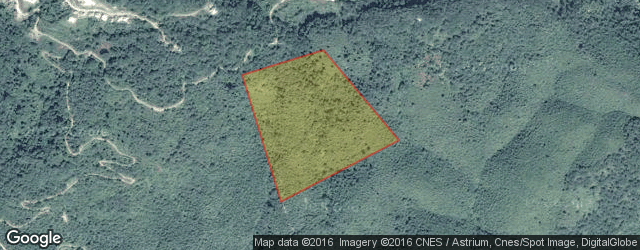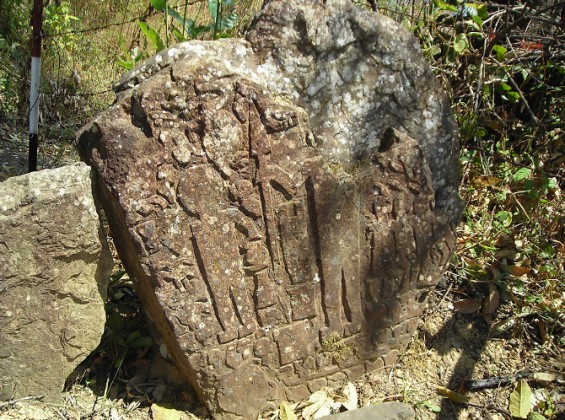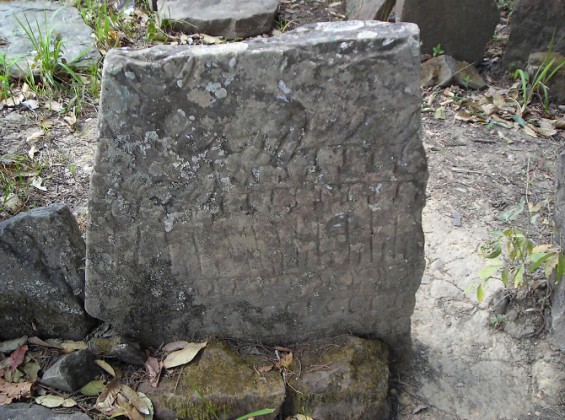Kawtchhuah Ropui: An Anthropological Evidence, (January 2002) — H. Lalnunmawia Recently explored ancient monuments or menhirs of ‘Kawtchhuah Ropui’ were bearing fruitful testimonies to study the inhabitants of Kawtchhuah Ropui area, that of the unknown past. Kawtchhuah Ropui literally means ‘the great entrance of the village’.
In most tribal societies of this region, a cluster of memorial stones were traditionally erected in the entrance of settlements in commemoration to their dear ones, braves or outstanding persons who won victories in war or hunting untamed animals. However, the uniqueness of Kawtchhuah Ropui has been seen that all the figures were embossed. It may be assumed that the dressing of Kawtchhuah Ropui stones might be done with fine iron-tools. From this point of view, I strongly opined that the past Mizo people were impossible to erect all these well-dressed stones due to lack of iron tools among the Mizos till the British colonial power.
Succession of the Past Settlements: Findings of potsherds near Kawtchhuah Ropui showed that there were two successions of settlement in this area. The typology of dressing clay-pots confirms this hypothesis. There have been found two types of potsherds, greatly differed from each other in its dressing – the first had irregular threads of dress-finishing and well-baked while the second one bore regular threads resembling the Mizo traditional techniques of dressing clay-pots. These striking features help us confident to conclude that two successions of human settlement must confine to this place. So, who would occupy this place?
Oral History told us that the Vangchhias, a sub-clan of the Mizo Tribe were once halted and settled at the present Vangchhe Village. The Vangchhias planted a banyan tree at the north western entrance of the present Vangchhe Village which was died of old age in 1911 and a new banyan tree was then replanted by the present dwellers in 1913. (Source: Oral Tradition given by Pu Doliana) Tree Life-Span is a simple method for dating. By applying this method, the life-span of a banyan tree in hill slope of a tropical region is around 250 – 300 years while in river valleys or more fertile soils it may be up to 450 – 500 years. If the oral tradition was true, the Vangchhias would started to settle there at around 1661 A.D. – 1611 A.D.(1911-250+50). So, the second settlement must be built by the Vangchhias. It has been a big question who would occupy this place in the first settlement.
A meager account of Cross-cultural Dating revealed that the Meiteis might be the ancient people who left these living cultures.
- First Assumption: Embossed figures have been found in the areas of Vangchhia, Lianpui, Zotlang-Champhai and in the northern part of Manipur. They were, to a great extent, resembled each other.
- Second Assumption: Prominent footpaths have also been found across Manipur, Myanmar and Mizoram which have been traced to interlink.
- Third Assumption: Uniqueness of typology of potsherds which were found in the old site of Vangchhe Village shows that potsherds were intermingled out of the Mizo tradition.
Manipur History: We may extract few statements about the chronology of the Manipur History to support the present view: “The Early Period (33 AD-1149 AD) Talking about the Early Period in the history of Manipur, we go back to the 1st century AD, when Nongda Lairen Pakhangba ruled over the region. He ascended the throne in 33 AD. After him, it is Meidingu Yanglou Keiphaba whose mention has been found in the historical records, with his reign lasting from 965 AD to 983 AD. The last major name of the Early Period is that of Meidingu Loitongba, who ruled from 1121 AD to 1149 AD. His son Atom Yoireba ascended the throne in 1149 Ad, but by 1162 AD he was driven out by his brother Hemtou Iwang-Thaba. The Medival Period (1467 AD-1798 AD) The Medival Period in the history of Manipur brings forth the name of Medingu Senbi Kiyamba, who became king in 1476 AD, at the age of 24. He was a friend of the King of Pong (Shan Kindom), who presented him with a stone, known as PHEIYA (Almighty). It was after this that worship of God, in the form of a sacred stone, was started.
From 1708 AD to 1747 AD, the region of Manipur was under the rule of Meidingu Pamheiba, who extended his kingdom from Kabow valley, in the east, to Nongnang (Cachar), Takhel (Tripura), in the west.” Between the early period (33 AD-1149 AD) and the medieval period (1467 AD – 1798 AD), there has been a time gap of 200 years, that is, 1200 AD – 1400 AD. By 1162 AD, Atom Yoireba, son of King Meidingu Loitongba was driven out by his brother Hemtou Iwang-Thaba, possibly southwards. Thus, the inhabitants of Kawtchhuah Ropui might be the descendants of Atom Yoireba. If it was, the period of Kawtchhuah Ropui might be around 1200 AD – 1400 AD. However, fruitful testimony can only be made when Thermoluminescence (TL) Dating for potsherds and Carbon Dating for Charcoal left by the inhabitants of Kawtchhuah Ropui are carried out.
Source: http://wikimapia.org/17680175/Kawtchhuah-Ropui-at-Vangchhe-Village









This is really a good post but I would like to point out some things,
1. If it was impossible for ancient mizos to erect such menhirs, because there was no iron tools for that time. Would it also not be that, even for the ancient manipur, it would be impossible, because, they wouldnt have iron tools either.
2. Why is it that, the meiteis dont have much megaliths like it is there in mizoram?. They must make better more beautiful ones in manipur, right?
3. The pathway leading to manipur to maynmmar, and the others, could signify that this could be used for trading centre as well in the hilly nation, or, the chinese or other indo china nation connection.
4. Lastly, The mizos people claim to be one of the lost tribe pf israel. and, the facts are quite legit. It is a high chance that they must be.. And, israelis already had iron tools since the old days,, or maybe this last point is not debatable.